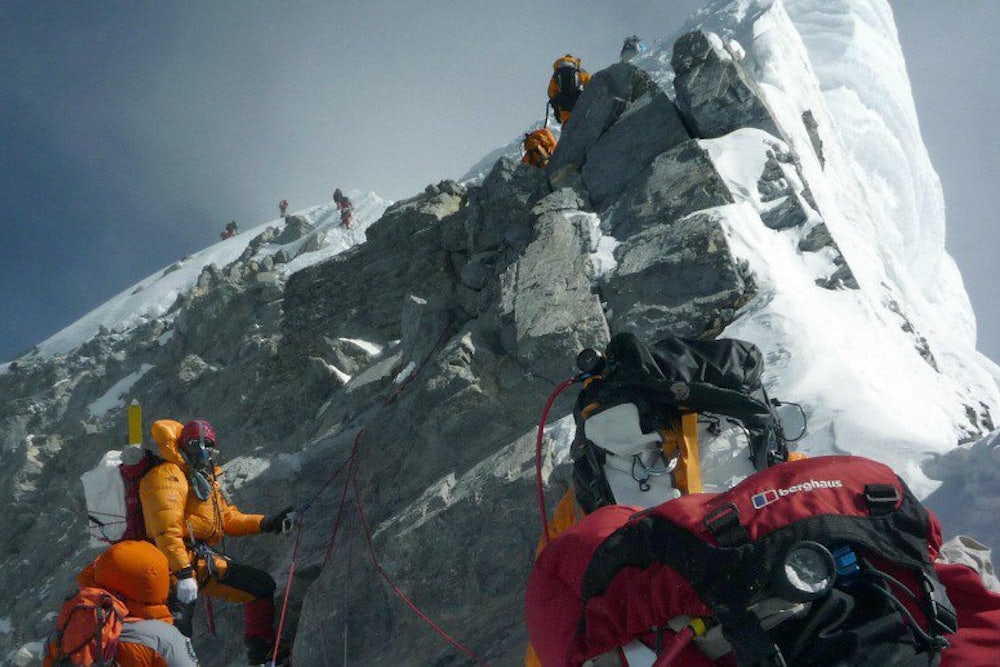I fear it is probably true to say that I have been acquainted with the upper slopes of Mount Everest in Nepal for longer than anyone else alive—ever since, in fact, I welcomed Ed Hillary and Tenzing Norgay down from the first ascent of its summit on May 29, 1953.
Over the decades since then my feelings towards that greatest of all the mountains have fluctuated. I have never thought it the most beautiful of peaks, but when I first experienced its presence I wrote that I knew of nothing vaster, in a transcendental sense, except perhaps Milton’s Paradise Lost. It possessed an allegorical aura for me, and offered more than mere sporting or patriotic meaning—a profound and indefinable mystery of its own.
At first, of course, like everyone else, I thought of Everest as essentially triumphant; triumphant in itself and bestowing triumphs upon others. People spoke of its ascent as a victory, its climbers as conquerors. I myself defined that first achievement as a last hurrah for the British empire. After Tenzing and Hillary, countless other mountaineers from all over the world, private and public, military and civilian, pitted themselves against that most iconic of opponents, returning home fêted as champions of their respective tribe, army or climbing club.
It was marvellous. It was exciting. It brought fame and rewards to its exponents and a modicum of new prosperity to the mountain’s native Sherpas. But for me, as the years went by, the allure of it all was tainting. Everest itself, I felt, was tainted by it, its lonely glory diminished. Before long, the tentacles of tourism had reached into the remotest western valleys of Nepal, deposited its agents in the base camps of Everest and, for a fat fee, even escorted its hundreds of customers to that ultimate summit, depositing their trash in passing. “Because it’s there,” was George Leigh Mallory’s reason for wanting to climb Everest back in the 1920s. “So that I can say I’ve done it,” was the mass retort a century on.
So my feelings about that tremendous mountain, which played a seminal part in my own life, reluctantly shifted. Old disciple that I was, the spell had faded and I began to feel a sort of pity for Mount Everest. It reminded me rather of some magnificent wild beast, dressed up for a circus performance or a TV show. And in the course of this display, people lost their lives—Sherpas, climbers and tourists alike—to remind us now and then that it was not all make-believe.
For sometimes that mighty presence did hit back, and in the early summer of 2015, in the sixty-second year of my acquaintance with the mountain, an unprecedented earthquake fell upon Nepal and caused a cruel avalanche to sweep down the slopes of Everest. A tented base camp was obliterated and many people were killed. Far, far more died elsewhere in the country, but it was inevitable, when the fearful news of the quake broke upon the world, that the media seized upon Everest for headlines. The very name of the peak, for all its recent flippancies, still spoke of drama, danger and the threat of tragedy.
As for me, the transcendental spell of the mountain was reactivated by the calamity, and, out of all the miseries, my old awe of it re-emerged. For me, it was Paradise Lost once more—a presence beyond tears or measurement. The Sherpas, whose mountain it is, call it Chomolungma, said to mean “Goddess Mother of the World,” and when Tenzing reached its summit all those years ago he buried in the snow biscuits, sweets, and chocolate in thanks to that divinity. Other Himalayan mountains have been more publicly sanctified. When the third-highest of them all, Kanchenjunga, was climbed for the first time in 1955, by official agreement its climbers refrained from setting foot actually on the summit at all—a tradition that endures to the present day.
Is it not time, I wonder now, for Chomolungma itself to be recognized not just as a World Heritage Site, but as a universally recognized Site of Holiness, left alone there in its ethereal majesty, out of bounds to all human beings and never to be violated again by the crudities of fame, profit, sectarian rivalry, or national pride? It could stand in silent memorial, perhaps, to all the people of Nepal who have lost their lives in the tragedy of 2015.
The Peak of Kindness, I myself would call it, a wishful name to be translated into multitudinous languages, and quoted from afar.
This article first appeared in New Statesman. Read the original here.
